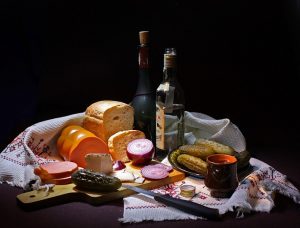
Vodka with food? For many Westerners this might be an unusual combination, because they drink alcohol separately – although many of them love to have wine after meals. But in Scandinavia, Poland and the countries of the former USSR, where vodka is the national alcoholic beverage, it has been drunk for centuries with food. According to some, this is due to the fact that good wine, considered the ideal companion for a meal, has always been a very expensive pleasure in these countries, while vodka was cheap and affordable for most people. But actually, there are more facts than just that. How important is vodka in Russian food serving, really?
The beginning of vodka’s appearance on the dining table
It must be remembered that, historically, Russia was relatively isolated from the rest of Europe and its wine culture in the past. Its national cuisines independently developed in its own land while the production of vodka was in its infancy. This made the link between the two appeared unintentionally. So, traditional Russian snacks started to appear in the 18th century, right when the production of home-made vodka reached its peak. Wine was affordable only for the Russian aristocracy. But, even though the high class could afford wine, they still chose to drink vodka (often flavored); because they believed that it was more consistent with the taste and nature of the local food.
The science behind the combination of food and alcohol
Alcohol and fatty foods act simultaneously on each other. On one hand, alcohol dissolves fats and enhances appetite. On the other hand, fat forms a protective film on the surface of the gastric mucosa, which slows down the flow of ethanol into the bloodstream and intoxication, therefore, it seems to a person that it is still far from the norm.
The pancreas equally does not fancy the combination of fatty dishes and ethanol. Since to break down fats and make them liquid is the direct function of this organ, the worst of all is if homogenized fat such as modified vegetable oil, cooking oil, margarine enters the body. It is especially difficult to deal with such substances in the pancreas, which is why pancreatitis is seriously a threat for fast food lovers.
Based on the scientific facts above, we can see why not all Russian food is good to go with vodka. But, amazingly, most of the local cuisines that are usually accompanied by the spirit seem to enhance the vitality of the Russians’ digestion.
Russian traditional foods that go well with vodka
Caviar
Usually, salted fish and fish products are recommended for vodka. For generations, Russians have been drinking vodka with black caviar, and this combination has become – like the sable, nesting dolls or ballet of the Bolshoi Theater – a symbol of the country. In the West, black caviar is one of the most expensive delicacies, while in Russia it has long remained relatively inexpensive. Vodka should be served very cold, and caviar is served on hot bread or with pancakes, which are popular not only in Russia, but in all Eastern European countries.
Sometimes vodka is accompanied by thinly chopped raw onions with a grated boiled egg. Salinity of fish and dry vodka said to complement each other. Black caviar is a distinctive Russian product, while in northern and eastern European countries, caviar of other fish is usually served – trout or salmon, often with pancakes, sour cream and thinly chopped onions.
Smoked and salted fish
Smoked or salted salmon and trout are also eaten with vodka in Russia, usually sturgeon, as well as pike and whitefish. But the most popular is Baltic herring, smoked or salted. Finely chopped onions with sour cream often accompany vodka, as well as sauces such as mustard and horseradish. Fish dishes prepared in this way are common snacks. If the fish become part of the main course, they are served with simple boiled potatoes.
Meat
In Russia, vodka accompanies most of the dishes of national cuisine, including those prepared from meat. They can be a baked pig with buckwheat porridge, dumplings, or solyanka (fatty, hot, spicy soup). Vodka is served even with a traditional national dish; duck with cranberries. There is a very definite logic in this. All these dishes, fatty, heavy and nutritious, can eclipse such a refined drink as wine. But strong, chilled vodka will not only resist their rich and vibrant taste, but will also help to break down heavy fatty foods.
Traditionally in Russia, slightly salted jellied of different types of meat is especially well combined with cold vodka. Horseradish and mustard are served with the dishes to emphasize the aroma of not only the food but also the vodka itself. All of the above is very exotic to the western taste.
Why Russians should have vodka with their meals?
The main purpose of vodka in Russian cuisine is that it is a must-have appetizer. Meals can be both hot and cold and served on large tables during festivities or parties. Appetizers are served in small portions, whether it is the already mentioned fish, caviar or an abundance of meat and vegetables. There are so many of them that it is impossible to list everything. However, preference is given to pickled mushrooms, sauerkraut, smoked meat, ham or spicy sausages.
The most important thing when drinking alcohol is moderation. If a healthy person takes one or two glasses of vodka with a few slices of bacon or fat ham, nothing bad will happen. When choosing a snack, you can use the following tips: strong alcoholic drinks go well with boiled or baked potatoes (if the stomach is healthy, then fried potatoes are fine), the simultaneous use of sugary drinks and desserts should be avoided. Alcohol is suitable for meat, fish, seafood or fruit, but not with the sweets.
